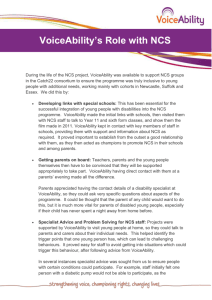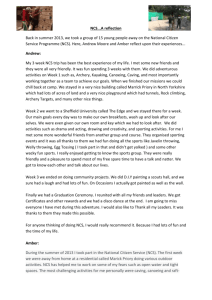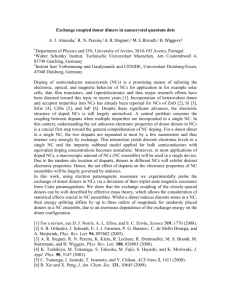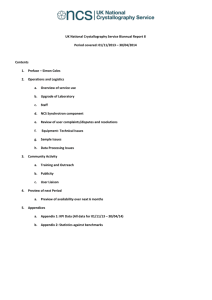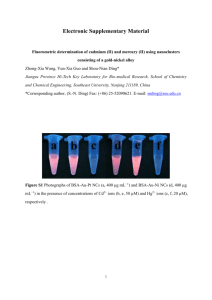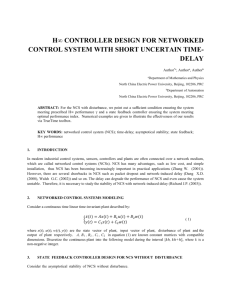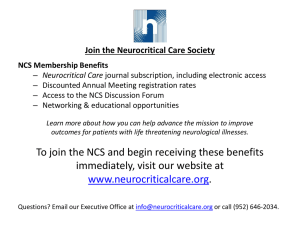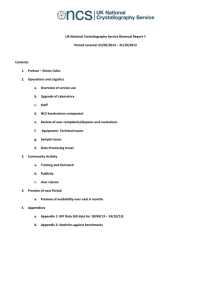Biannual Report 9 - National Crystallography Service
advertisement
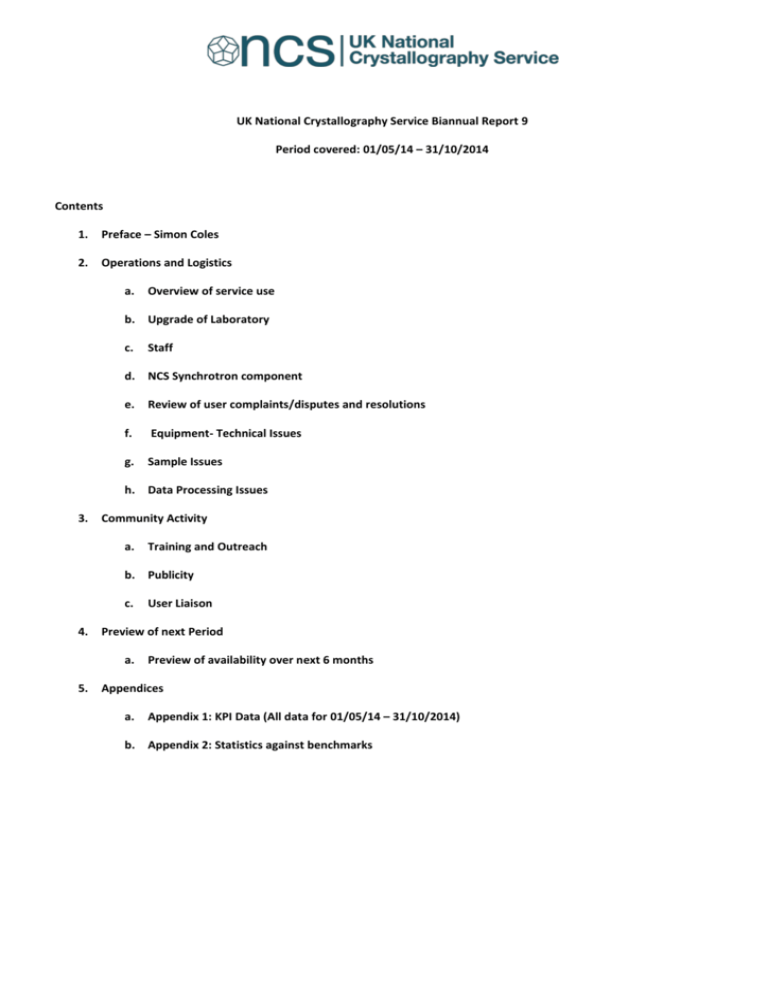
UK National Crystallography Service Biannual Report 9 Period covered: 01/05/14 – 31/10/2014 Contents 1. Preface – Simon Coles 2. Operations and Logistics a. Overview of service use b. Upgrade of Laboratory c. Staff d. NCS Synchrotron component e. Review of user complaints/disputes and resolutions f. Equipment- Technical Issues g. Sample Issues h. Data Processing Issues 3. Community Activity a. Training and Outreach b. Publicity c. 4. Preview of next Period a. 5. User Liaison Preview of availability over next 6 months Appendices a. Appendix 1: KPI Data (All data for 01/05/14 – 31/10/2014) b. Appendix 2: Statistics against benchmarks 1. Preface Period 9 continued to consolidate NCS operations with staff, instrumentation and operating procedures well established. However, Dr Claire Wilson departs the NCS post at Diamond for a permanent position as the Staff Crystallographer in the Chemistry Department at Glasgow University – we wish her well and thank her for her tremendous hard work whilst being in post. The vacant position will take some time to fill and therefore we have temporarily appointed Dr Tony Keene in Southampton to help cover the shortfall. The interface with Diamond and our resulting beamtime has been running very smoothly, with a steady flow of publications arising, and it will be paramount to ensure that this position is retained when recruiting Claire’s replacement. The NCS remains the highest volume and most experienced user of the beamline. Accordingly we see a greater diversity of samples and types of chemistry than any other user group and have been furthering our studies into crystal decay in the x-ray beam – an effect we are observing with more frequency than ever before. The next phase of results will be presented in posters at international conferences. The usage and performance statistics for the overall operation of the service are in a steady state at the moment – being very comparable to previous periods. Being the International Year of Crystallography in 2014, the NCS has been significantly involved in Outreach Activities. In this period we have either conducted or provided significant input into a number of events and promotional activities ranging from Grantham to Kenya! The NCS is overlapping more with others in the EPSRC Mid-Range Facilities programme and this has been put into practice by attending an RSC Young Scientists event in Nottingham, where the NCS, the National Mass Spectrometry Service and the Chemical Database Service had a joint stand. We have exchanged promotional material, such as powerpoint slides and fliers, in order to further enable this route to reaching out to a wider audience (with minimal overhead to all services). The interaction with the CDS is particularly strong with collaborative projects on data management being scoped. 2.Operation and Logistics A. Overview of service use Service use remains consistent, with the number of users and completed samples remaining roughly constant since the last allocation period. The number of days the Facility is available for NCS use is slightly down due to on-going problems with ageing cryogenic equipment. All benchmarks were met. The rapid access scheme continues to attract new users between calls, the majority of whom go on to apply for regular access at the following routine call for applications – so whilst the number of users remains roughly constant, there is actually a cycling of some new users replacing those who don't currently require our services (can be up to around 10 users each 6 month period). B. Upgrade of Laboratory No upgrades were planned or undertaken. C. Staff A significant staffing change is going to be occurring. Dr Claire Wilson is leaving at the end of the period for a permanent position as the Staff Crystallographer in the Chemistry Department at Glasgow University – we wish her well and thank her for her tremendous hard work whilst being in post. She was the first employee to be employed by Diamond and required to bridge to the Southampton operation – and she defined the role and made it work. Accordingly there are no major changes planned to the structure or role of this post and discussions have been had with Diamond and a job advert is out – it is expected that interviews will be held towards the end of the year. The vacant position will take some time to fill and therefore we have temporarily appointed Dr Tony Keene in Southampton to help cover the shortfall. Extra expert analysis is now required to address the increasingly challenging samples being submitted and Tony will help in this regard as well as forming part of the beamtime team. D. NCS Synchrotron component Access to I19, Diamond continues to be through the successful NCS block allocation group (BAG) 2 year program mode, which makes the NCS one of the main users of the beamline. NCS had 5 days (each of 24 hours comprising a block of 3 shifts) allocated in the current 6 month period (1/05/1431/10/14), however one of these was lost due to machine issues. Typically 10-20 samples have been screened during a visit and around half of these will lead to data collections. This is highly sample dependent and varies considerably from visit to visit. Our continued use of the Helix for very low temperature (30K data collection) has been very successful and we continue to typically have one day of the allocation with the Helix. E. Review of user complaints/disputes and resolutions There have been no complaints reported to either the NCS Director or Head of Service and therefore no complaint or dispute resolution has been initiated. F. Equipment- Technical Issues Routine maintenance has been performed on diffractometers. The following summarises diffractometer-based issues and resultant instrument downtime that have arisen in the reporting period: • Planned annual service (2 days) • Chiller controller and fans replaced (9 days) • FRE+ filament change (1 day) • Bearing replacement (1 day) All the above replacements and servicing have been carried out under warranty and/or service contract. The cryogenic devices have suffered the following problems: One Cryodrive on the FR-E+ system failed, necessitating a return to Oxford Cryosystems for servicing/repair. Accordingly one of the diffractometers was only able to operate at room temperature for a period of 3 days. G. Sample Issues Several persistent issues continue: - Partially completed submission forms, particularly with sample related information missing (such as solvent/air sensitivity, possible photo reactivity, melting point of crystals). A number of users do not supply reaction schemes or expected formula. - Still a number of Schlenk flasks, long NMR tubes or very small, blind-necked vials often contain large amounts of solvent (mother liquor) and/or only a few crystals which are difficult to manipulate. - A number of submitted samples have more than one type of crystalline material (different crystal type, habit, colour, etc), however users have not specified which type should be examined. - A number of samples which degrade quickly do not have low temp storage requested. - A number of samples which are described as solvent sensitive are sent either without solvent or in vials which are not properly sealed to prevent evaporation. H. Data Processing Issues Following successful testing in the last period and early part of this period we are using CrysAlisPro to process the data for most samples. 3. Community Activity A. Training and Outreach We took part in two primary science days with a series of activities themed around international year of crystallography. Several of the schools involved took away materials for use with other classes and to put up displays in the school about the international year. We hosted several A-level work shadowing placements and an internship. B. Publicity The service continues to publicise its activities where appropriate. Flyers are distributed around call periods along with direct emails to users past and present. The rapid access scheme continues to bring in new users between calls. C. User Liaison We continue to act on suggestions and comments from the users to refine and improve our systems. Building on this, we have been striving to make it clear to our user community that we can be highly responsive to urgent or unusual requests. This drive has led to good feedback from users requiring help with graphic design relating to their structures, the need for rapid turnaround times to include results in lectures and important reports/dissertations/theses/papers, suggesting additional collections to help with difficult samples and advanced experiments such as variable temperature studies and charge density. 4. Preview of next period A. Preview of availability over next 6 months Aside from University closed days over the bank holiday periods, the only planned closure during the next period is for the BCA spring meeting in April 2015. B. Preview of upgrade over next 6 months None planned. Appendix 1: KPI Data (All current data for 01/11/13 – 30/04/14) This period May – Nov 2014 Nov 2013 – May 2014 May – Oct 2013 Nov 2012 – May 2013 May – Oct 2012 Oct 2011 – May 2012 Number of NCS Users (active) 65 68 64 67 65 67 Number of NCS Projects 65* 68* 64* 67* 65* 67* Availability of facility for NCS use (days) 94 93 92 108 110 106 Actual equipment uptime and use of facility by or for NCS 67 86 78 94 100 92 Number of NCS samples processed Total 403 443 376 432 417 421 At Southampton 350 377 316 376 353 333 At DLS 53 66 60 56 64 88 Number of NCS data collections performed 238 277 223 260 285 301 Number of Full structure determinations performed 165 166 153 172 132 120 Number of NCS samples outstanding 246 263 237 201 189 174 Waiting for examination 70 77 63 83 16 66 Processing 143 178 137 100 167 89 Waiting for return to users 33 8 37 18 6 19 Number of User data sets that were complete d within 1,2,3,>3 attempts 1 attempt 365 385 284 349 289 330 2 attempts 31 50 87 64 107 71 3 attempts 7 8 5 15 17 15 More than 3 attempts 0 0 0 4 4 5 Unreported 0 0 0 0 0 0 Number of User complaints received 0 0 0 0 0 0 Number of NCS research outputs 39 40 52 44 44 49 Number of NCS users of the training programme 0 2 0 0 1 1 Number of samples classed as routine or difficult Routine 252 248 185 190 265 265 Difficult 98 129 131 135 88 57 Synchrotron 53 66 60 40 64 88 Unreported 0 0 0 0 0 11 * Projects is an old metric - we used to allow more than one project per user, now operate a one allocation per user system Appendix 2: Benchmark statistics Benchmark 1 The time from arrival of a sample to logging in and informing a User of receipt will be within 2 working days for all samples. Achievement for this benchmark = 100% Benchmark 2 The time a sample is in the queue from logging it in to the first examination will be within 10 working days for 80% of high priority samples, within 20 working days for 80% for medium priority samples and within 30 working days for 80% of low priority samples. Achievement for this benchmark: High priority = 85% Medium priority = 87% Low priority = 82% Benchmark 3a The time a sample is in the queue from examination to communication of the result of the data collection to the user should be within 5 working days for 80% for Data Collection Only samples. The result of the data collection, for the purposes of this benchmark, is defined as any of the following: 1. 2. 3. 4. 5. Withdrawal of sample, Failure of sample, Decision to recollect (resulting in a new set of benchmark data for the recollection), Decision to refer to DLS (resulting in a new set of benchmark data for the referral), Provision of an .hkl file to the user. Achievement for this benchmark = 82% Benchmark 3b The time a sample is in the queue from examination to communication of the result of the data collection to the user should be within 20 working days for 80% of Full Structure Analysis samples. The result of a data collection, for the purposes of this benchmark, is defined as any of the following: 1. 2. 3. 4. 5. Withdrawal of sample, Failure of sample, Decision to recollect (resulting in a new set of benchmark data for the recollection), Decision to refer to DLS (resulting in a new set of benchmark data for the referral), Provision of a publication quality .cif file to the user. Achievement for this benchmark = 81%

